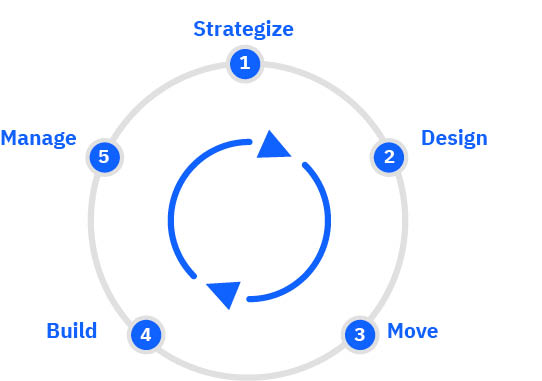The hybrid cloud platform advantage
Welcome to the era of unparalleled business transformation. Today, companies use cloud platforms and digital technology capabilities to discover new ways to leverage data for improved business performance. Cloud platforms are clouds that provide an integrated experience. Ideally, a platform scales and supports both small development teams and organizations, and large enterprise businesses. It can be deployed across data centers around the world.
Typically, cloud platforms are clouds—or multiclouds—in a single environment: public or private. A hybrid cloud platform takes that a step further, operating across two or more of these environments. Advanced companies are aligning their business transformation with the orchestration of their cloud platforms to achieve a next-generation business model. This next-generation model enables an agile organization fueled by data, guided by AI insights and built for change on a hybrid cloud—we call it The Cognitive Enterprise™. This transformation trend is likely to become even more important as organizations reset to do business post-pandemic.
The adoption of cloud has been a central feature in developing new, digitally-driven business models. However, some organizations are struggling with harnessing the full capabilities of their cloud environments. This stunts their ability to attain their target operating models.
Though 90 percent of companies globally were “on the cloud” by 2019, only about 20 percent of their workloads have moved to a cloud environment. These workloads have usually been microservices that are native—that is, born on the cloud. The next 80 percent of the cloud opportunity focuses on shifting core business applications and workloads to the cloud and optimizing everything from supply chains to sales. This next chapter of the cloud requires executives to invest in hybrid multicloud platform strategies and capabilities.
Five steps to implement a hybrid cloud platform

Enabling business transformation
To develop IT environments that enable business transformation, whether supporting specific workflows or a wider operating model, CIOs need to be able to offer capability that seamlessly integrates tasks across different types of clouds and entire IT infrastructures. Enterprises need an application development platform that can run on any cloud, workloads that can execute seamlessly across multiple clouds, and a comprehensive orchestration capability that spans across clouds. A platform approach can play a unifying role and act as the technological glue that allows an organization to harness the full range of capabilities available to it for improved business and operational performance.
The value case for hybrid multicloud
Hybrid multicloud is the fundamental enabler of enterprise target operating models. Whereas, for many organizations, getting on the cloud was “what” they wanted to do, these new business models, applications and infrastructure are “why” they wanted to do it. While these new technologies can be compelling, the success or failure of cloud deployments are not technology stories; they’re business transformation stories.
It has been demonstrated that the value derived from a full hybrid, multicloud platform technology and operating model at scale is 2.5 times the value derived from a single platform, single cloud vendor approach. This has been validated across 30 companies in multiple industries. Indeed, a platform approach accelerates value with scale.
To better understand the business value of mature multicloud functionality and the use of multicloud management tools, we conducted a survey. Analyzing the findings, we identified and characterized a group of leading businesses that have successfully achieved demonstrable competitive advantage from adopting a robust hybrid cloud management and governance platform. Naming this group “Cloud Aviators,” we highlight major differences in strategic approach, decisions, actions, and behaviors that separate Aviators group from their peers.
Through regression analysis and other statistical techniques, we estimate business benefits and ROI that organizations may achieve. Taking five key steps to implement a cloud management platform that helps deliver the benefits of a hybrid multicloud environment. To this end, we characterize how Cloud Aviators strategize, design, move, build, and manage a hybrid multicloud platform in their organizations to achieve competitive advantage.
Meet the authors
Jim Comfort, General Manager, GTS Cloud Development and Delivery at IBMSteven Robinson, General Manager, Red Hat Synergy, IBM Hybrid Cloud
Blaine Dolph, IBM Fellow and CTO, IBM Consulting Assets and Industries
Lynn Kesterson-Townes, Global Cloud & Quantum Leader, IBM Institute for Business Value, IBM Consulting
Anthony Marshall, Senior Research Director, Thought Leadership, IBM Institute for Business Value
Download report translations
Originally published 01 May 2020






